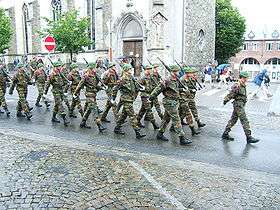Chasseurs Ardennais
| 10th Regiment of the Line 1830-1933 Regiment of Chasseurs Ardennais 1933-2011 Battalion of Chasseurs Ardennais (2011-) | |
|---|---|
|
A platoon of Chasseurs Ardennais parading in Bastogne | |
| Active | 1933- |
| Country |
|
| Branch | Land Component |
| Type | Infantry |
| Role | Mechanised infantry |
| Part of | Medium Brigade |
| Garrison/HQ | Marche-en-Famenne |
| Motto(s) |
Résiste et Mords! ("Resist and bite!") |
| March | Marche des Chasseurs ardennais |
The Bataillon de Chasseurs Ardennais (French; Battalion of Ardennes hunters) is an infantry formation in the Land Component of the Belgian Armed Forces. The unit, currently at battalion strength, is a part of the Medium Brigade. The unit was formed in 1933 when the 10th Regiment of the Line was renamed the Regiment of Chasseurs Ardennais, which it remained until 2011 when it was reduced to a battalion.[1] It is named after, and based in, the heavily forested and hilly Ardennes region of Belgium.
History
The origin of the Chasseurs Ardennais starts with a concept conceived in 1914 by Colonel Bremer and pushed further by General Hellebaut in 1928: the creation of a corps on the east border of Belgium, near Germany, in order to protect against a German attack. On 10 March 1933, King Albert I changed the unit's name from 10e de ligne to Régiment des Chasseurs Ardennais. Subsequently these soldiers, stationed in Arlon, Belgium would wear the wild boar (emblem of the Ardennes) on their green berets. One regiment was not enough to hold the east lines, so in August 1934, the regiment was divided into three and a bicycle battalion was added. On 24 March 1937, three regiments were created: 1st, 2nd and 3rd Régiment des Chasseurs Ardennais they were located in Arlon, Bastogne and Vielsalm. Each unit was structured with one HQ battalion, three battalions to three companies of mixed cyclists (three packs of riflemen and three packs of MG) one motorcycle company each with each three motorbike squadrons, and one squadron with three T15 tanks; one company with four T-13 tanks armed with 47mm antitank cannons; and finally one medical company. On July 1, these were formed into a division. By the end of 1939 this division comprised 35,000 men.
Second World War
In World War II the Chasseurs Ardennais took part in heavy fighting after Belgium was invaded on 10 May 1940; the Germans noted the fierce resistance of the Belgians and the Chasseurs Ardennais were no exception. In one engagement a 47mm antitank gun destroyed or disabled five German tanks.[2]
Battle honours

The unit's flag carries the following citations:
- Namur
- Termonde
- Yser
- Esen
- Kortemark
- Ardennes
- La Dendre 1940
- Vinkt
Uniform and Insignia
The Chasseurs Ardennais have, since their inception, worn a large green beret in addition to the uniform which the rest of the army wears. The insignia worn on the cap is the head of a Wild Boar which are found in the Ardennes region.
In popular culture
A square in Schaerbeek, Brussels is named after the Chasseurs Ardennais, as is a road in Vielsalm.
The Swedish heavy metal band Sabaton released an album called Heroes in May 2014, in which one of the tracks "Resist and Bite" is dedicated to the Chasseurs Ardennais.
References
- ↑ "Historique des Chasseurs Ardennais". mil.be. Retrieved 13 December 2012.
- ↑ (French) Troupes d'Elite Volume 2. Editions Atlas, 1986
- (French) Troupes d'Elite Volume 2. Editions Atlas, 1986
External links
| Wikimedia Commons has media related to Chasseurs Ardennais. |
- "Régiment de Chasseurs Ardennais" (in Dutch). Defence Belgium. Archived from the original on 26 September 2007. Retrieved 2007-09-03.
- "Régiment de Chasseurs Ardennais" (in French). Defence Belgium. Archived from the original on 15 August 2007. Retrieved 2007-09-03.
